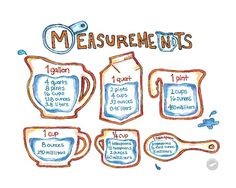Did you ever realise that your kitchen can be like an in-house classroom and a great space for learning? Well it can. In your kitchen, you can learn lots of different things other than just learning how to make a meal, like mathematics for instance. Even the simplest recipes require basic math skills. However, (How can math help you cook?, 2015) says expanding upon recipes can take you even deeper into fractions, multiplication, estimations, proportion and division!
Our kitchen is full of various tools that can link to mathematics in many ways. For example, (LZXpress, 2010) states that a measuring cup and jugs links to maths due to the use of measurement. If you were measuring solids and dry ingredients such as peanut butter, flour and caster sugar you would use a measuring cup. If you were measuring liquids such as water, you would use a measuring jug. Measuring jugs are split in to two sides, one side measuring cups and ounces, and the other measuring litres (l) and millilitres (ml).
For example, do you know the difference between a teaspoon and a tablespoon? They may not look that different, but (LZXpress, 2010) expresses when it comes to putting 3 tablespoons of salt in to your soup instead of 3 teaspoons, that is when it all goes wrong. I like to remember teaspoon as something you mix your cup of tea with, this helps me remember the difference. “A teaspoon is a common culinary measurement that’s equal to approximately one-sixth of a fluid ounce. A tablespoon is equal to three teaspoons.”
Moreover, if you are reading a recipe that is suitable for four people, but you want to make it for eight people, what do you do? Well four is double two, so you would double everything in the recipe. So for example, a cake recipe includes two eggs, you would use four eggs and so on. This way, the cake will be double the amount.
(How can math help you cook?, 2015) quotes “If a recipe calls for six teaspoons of vanilla extract and you want to double the recipe, how many teaspoons of vanilla extract would you need to include? If you only have a tablespoon, how many tablespoons of vanilla extract would you include? If you said twelve teaspoons and four tablespoons, you’re ready for the kitchen!”
https://www.youtube.com/watch?v=wQkCBhQd7wM
How can math help you cook? (2015) Available at: http://wonderopolis.org/wonder/get-cooking/?replytocom=663004 (Accessed: 25 November 2015).
LZXpress (2010) Math in the kitchen. Available at: https://www.youtube.com/watch?v=wQkCBhQd7wM (Accessed: 1 December 2015).


